Philipp Bauknecht
Philipp Bauknecht (1884, Barcelona - 26 February 1933, Davos) was a German Expressionist painter and graphic artist. Most of his works are landscapes and still-lifes.
Philipp Bauknecht | |
|---|---|
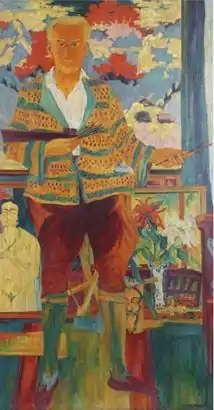 | |
| Born | Barcelona, Kingdom of Spain |
| Died | 26 February 1933 (aged 48) Davos, Switzerland |
| Nationality | German |
| Known for | Painting |
| Movement | Expressionism |
Biography
He was born in Barcelona, where his father was working as a watchmaker and goldsmith. In 1893, his family returned to their hometown of Schramberg. He later completed an apprenticeship at the carpentry school in Nürnberg, then attended the State Academy of Fine Arts Stuttgart where he studied with Bernhard Pankok. Upon graduating, he joined the school's staff.
Around 1910, he was diagnosed with tuberculosis and moved to Davos, a spa town in Switzerland, where he became friends with the writers Klabund and Erwin Poeschel. The surroundings of the Swiss Alps and his illness inspired him to create works dealing with mountains, landscapes, villages, ice skating, hiking, rural life, illness and death.[1]
Even though his health improved, he refused to return to Germany, as he was opposed to the war. He apparently lived very poorly, in a log cabin, and the proceeds from his first exhibition were seized to pay off debts. During this time, he became severely misanthropic; satirizing the people of Davos and the guests who came there to visit the spa. In 1917, one of those guests was the famous artist, Ernst Ludwig Kirchner. At first, they were friends, but slowly became enemies. Bauknecht accused him of being unable to paint unless he was drunk and rejected the idea that Kirchner had influenced him.
After 1920, until his death, he exhibited his paintings and woodcuts widely throughout Switzerland and Germany. In 1925, he married the wealthy Ada van Blommestein, from the Netherlands, and travelled with her there. They had one son. Although he was now financially secure, his health began to deteriorate, so he returned to Davos and died there in 1933, while having an operation for gastric cancer. Ada took his remaining works to Baarn, in the Netherlands, and hid them from the Nazis.[2] In Germany, his paintings were declared "degenerate art" and some were displayed at the Degenerate Art Exhibition in Munich in 1937. Most of his work there was eventually destroyed or lost. It wasn't until 1960 that his works were rediscovered and reevaluated.[3]
Selected paintings
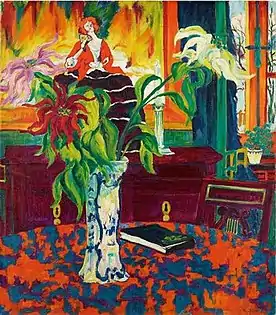 Floral Still-life with Book
Floral Still-life with Book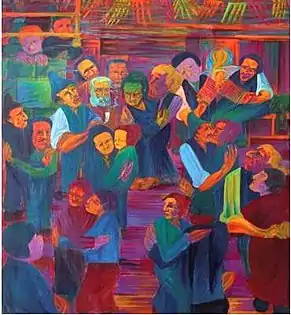 Alpine Fair, Dance
Alpine Fair, Dance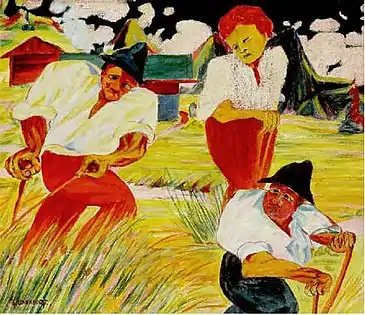 Farmers in the Field
Farmers in the Field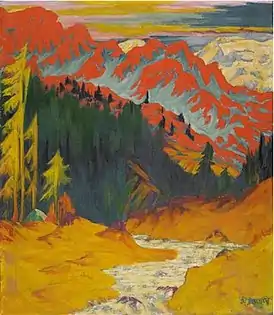 Autumn in the Mountains
Autumn in the Mountains
References
- Monika Köhler: Die Neuentdeckung eines Pioniers. In: Südkurier vom 29. April 2014.
- Bauknecht. Im Versteck. Malerei. In: Der Spiegel 34/1961 vom 16. August 1961
- Gerd Presler: Philipp Bauknecht. Expressionist in Davos 1884–1933 bei presler.de
Further reading
- Paul Pieper, Rudolf Utzinger: Philipp Bauknecht: Gemälde, Aquarelle, Holzschnitte. Münster: Freie Künstlergemeinschaft "Schanze", 1963.
- Gioia Smid (Ed.): Philipp Bauknecht: Expressionist in Davos, 1884 – 1933. Bussum 2002. ISBN 90-6868-313-6.
- Beat Stutzer (Ed.): Expressionismus aus den Bergen. Ernst Ludwig Kirchner, Philipp Bauknecht, Jan Wiegers und die Gruppe Rot-Blau. Zürich: Scheidegger und Spiess, 2007. ISBN 978-3-85881-190-5.
- Sylvia Laun, Phillip Bauknecht (1884–1933), Leben und Werk. Europäische Hochschulschriften, Frankfurt am Main 1992, Peter Lang, ISBN 3-631-44095-2
- Thorsten Sadowsky; Beat Stutzer: Phillip Bauknecht (1884–1933) (exhibition catalog, Museum Würth), Swiridoff, Künzelsau 2014, ISBN 978-3-89929-287-9